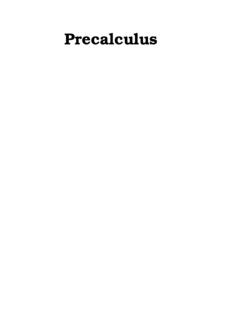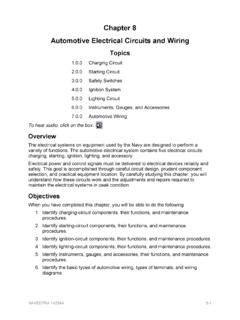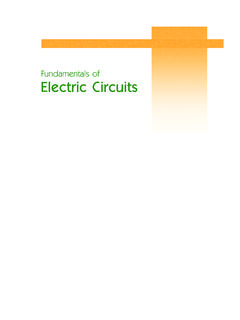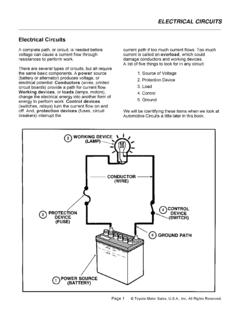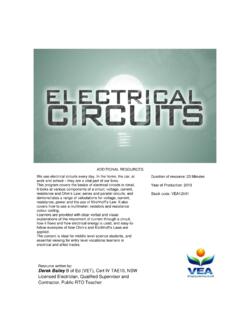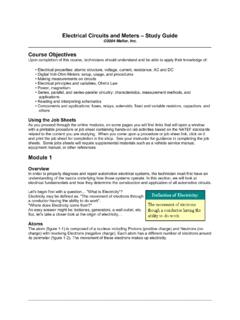Transcription of Electrical Circuits - University of Washington
1 Application ofLinear AlgebrainElectrical CircuitsSeamleng TaingMath 308 Autumn 2001 December 2, 2001 Table of of Linear Algebra in Electrical CircuitsSimple Series or Parallel CircuitsNodal Voltage Analysis and Loop Current AnalysisGaussian Current Analysis using Gaussian EliminationNodal Voltage Analysis using Gaussian Algebra in Electrical CircuitsPerhaps one of the most apparent uses of linear algebra is that which is used inElectrical Engineering. As most students of mathematics have encountered, when thesubject of systems of equations is introduced, math class is temporarily converted into acrash course in Electrical components. There, the resistor, voltage source and capacitortake the stage as well as their accompanying language consisting of Kirchoff and the basic concepts down, math class is resumed and students can look forward toplaying with n number of equations with n number of unknowns.
2 To solve for thecurrents and voltages, students can use simplification and substitutions, but with manyequations, this task quickly becomes very time consuming and , using Gaussian Elimination along with computers, engineers are able toefficiently calculate unknown values of extremely large and complex systems withoutperforming hundreds of calculations and exhaustive bookkeeping of CircuitsToday more than ever, electronics are an integral part of our everydaylives. They contribute to every aspect of our way of life from lighting the space aroundour work environments, to exploring uncharted territories. But behind each and everyelectrical appliance or device, no matter what task it was designed for, lies a vast systemof Electrical components that must function as a whole. Each component (resistors,capacitors, inductors, etc.) has specifications of their own, as does the final product thatthey are a part of, so engineers must design their devices to meet not only their intendedpurpose, but so that the individual components are within their tolerances.
3 Vital to this isthe analysis of currents and voltages throughout the Electrical Series or Parallel CircuitsFor simple Circuits , such as those used in math textbooks to introducesystems of equations, it is often sufficient to use series and parallel relationships tosimplify Circuits . With this done, Ohm s Law (V=RI) can be used to find voltages or Vt=Rt*I I=I1=I2=I3=I4 V=RI6V=6V 6V=3 Ohm*I 2A=2A=2A=2A=2A V1=20V I=2A V2=30V V3=30V V4=20 VLarger Circuits though, are a problem, as this method is no longer efficient. It becomes fartoo time consuming to analyze and reduce Circuits . Instead a new method of determiningvoltages and currents is used called Nodal Voltage Analysis and Loop Current Voltage Analysis and Loop Current AnalysisUsing Nodal or Loop Analysis, we end up with systems of equations with unkownvariables.
4 By simplifying and manipulating these equations, eventually all the unknowns will besolved assuming there were the same number of equations as there were (1/76)(25i2+50i3+10) -> -25((1/76)(25i2+50i3+10)) + 56 i2 - i3 = 0(-625/76) i2 (1250/76) i3 (250/76) + 56i2 - i3 = 0(3631/76) i2 (663/38) i3 = (250/76) -> i2 = (1326/3631) i3 + (250/76)-50(1/76)(25 [(1326/3631) i3 + (250/76)] + 50i3+10) - (1326/3631) i3 + (250/76) + 106i3= 0i3 = , i2 = , i1 = method too, has its pitfalls, as Circuits with many loops or nodes will require manysubstitutions, not to mention the large task of keeping track of all the EliminationTo fix the problem of dealing with all the bookkeeping of variables, a simplechange of notation is required. That is, to place the equations into a matrix the columns are of the same variable, it is easy to see that row operations can bedone to solve for the method is known as Gaussian Elimination.
5 Now, for large Circuits , this will still be along process to row reduce to echelon form, but it s a know fact that computers lovematrices. With the help of a computer and the right software, ridiculously large circuitsconsisting of hundreds of thousands of components can be analyzed in a relatively shortspan of time. Today s computers can perform billions of operations a second, and withthe developments in parallel processing, analyses of larger and larger Electrical systemsin a short time frame are very 1- Loop Current Analysis Using Gaussian EliminationLoop Equations:1i1 + 25(i1-i2) + 50(i1-i3) = 1025(i2- i1) + 30(i2- i4) + 1(i2- i3) = 050(i3- i1) + 1(i3- i2) + 55(i3-i4) = 055(i4- i3) + 30(i4- i2) + 25(i4-i5) + 50(i4- i6) = 025(i5- i4) + 30 i5+ 1(i5-i6) = 050(i6- i4) + 1(i6- i5) + 55 i6 = 0 Collect terms:76i1 - 25i2 50i3 + 0 i4 + 0i5 + 0 i6 = 10-25i1 + 56 i2 1 i3 30 i4 + 0i5 + 0 i6 = 0-50i1 1 i2 + 106 i3 55 i4 + 0 i5 + 0 i6 = 00i1 30 i2 55 i3 +160 i4 25i5 50 i6 = 00i1 + 0 i2 + 0 i3 25 i4 + 56i5 1i6 = 00i1 + 0i2 + 0i3 50 i4 1i5 + 106 i6 = 0 Write as Augmented Matrix.
6 76 25 50 0 0 0 10-25 56 1 30 0 0 0-50 1 106 55 0 0 00 30 55 160 25 50 00 0 0 25 56 1 00 0 0 50 1 106 0 Row reduce using calculator or program:1 0 0 0 0 0 .4780 1 0 0 0 0 .3480 0 1 0 0 0 .3530 0 0 1 0 0 .2390 0 0 0 1 0 .1090 0 0 0 1 0 .114i1 = .478 A, i2 = .348 A, i3 = .353 A, i4 = .239 A, i5 = .109 A, i6 = .114 AExample 2- Nodal Voltage Analysis Using Gaussian EliminationN2 is the reference node as so the voltage is Equations:(V1/30) + (V1-100)/5 + (V1-V3)/10 = 0(V3 - V1)/10 + V3/10 + (V3-100)/20 = 0 Collect terms:[(1/30) + (1/5) + (1/10)] V1 (1/10) V3 = 20(-1/10) V1 + [(1/10) + (1/10) + (1/20)] V3 = 5(1/3) V1 (1/10) V3 = 20(-1/10) V1 + (1/4) V3 = 5 Write as Augmented Matrix:1/3 -1/10 20-1/10 1/4 5 Row Reduce to Echelon Form:1 0 750 1 50V1 = 75 V, V3 = 50 VBibliographyDorf, Richard C.
7 And Svoboda, James A. Introduction to Electric Circuits . New York:John Wiley & Sons, Inc. , Eric. Applications of Linear Algebra and Matrices to Electronics (31 Dec. 1996)Paij, Edwin. ampli Mosfet 200 W (2 Dec. 2001)

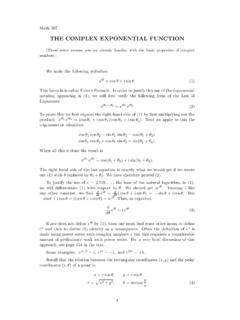

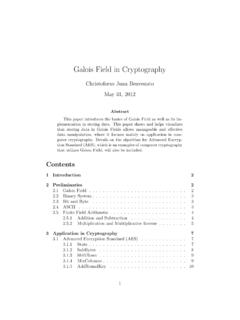

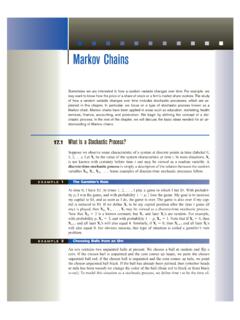
![ZZ dA R [0 2] R - University of Washington](/cache/preview/6/4/c/c/9/f/d/6/thumb-64cc9fd6ac93e2995c04a2a74b217176.jpg)
